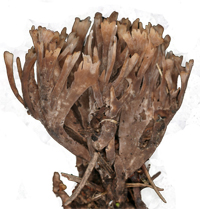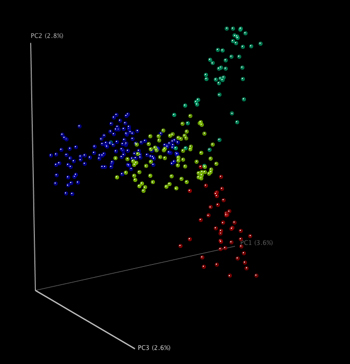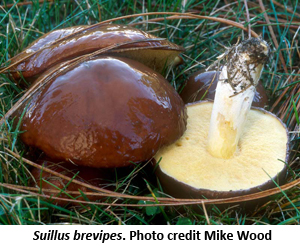About the DoED project
The Dimensions of Ectomycrorrhizal Diversity (DoED) project is focused on extending our knowledge of the taxonomic, functional and genetic diversity of ectomycorrhizal fungi in North American Ecosystems. To characterize taxonomic diversity we are engaged in a large field based sampling effort that includes sites spanning Alaska to Florida. At a finer genetic scale, we are collecting isolates of some common ectomycorrhizal fungi across their range and using genomic approaches to determine the degree of genetic variation across populations. Functional variation is difficult to characterize for organisms with few obvious morphological traits. In order to understand functional variation in ectomycorrhizal communities we are employing a variety of techniques - from the measurement of extracellular enzyme activitiy to quantification of gene expression - both in our field surveys and in experimental microcosms. As a result of this project we generate functional, taxonomic and genetic diversity maps for ectomycorrhizal fungi across North America, develop new methods for quantifying ectomycorrhizal functional traits and their impacts on ecosystem functions, and characterize the key biogeographic barriers affecting the dispersal of genes and species in North America. Some brief background on each aspect of the project is presented below:
MAPPING ECTOMYCORRHIZAL AND SOIL FUNGAL DIVERSITY ACROSS NORTH AMERICA
Thus far we have completed field sampling at 21 sites, depicted here. So that we can take into account the effects of host species identity on  ectomycorrhizal
ectomycorrhizal  community structure we have chosen to stratify our sampling across six species in the family Pinaceae that are common, often form monospecific stands, and have wide geographic ranges. At each site we take multiple samples in a spatially nested grid. This will allow us to look at variation in fungal community structure from the range of centimeters to 1000s of kilometers. In each sample we also measure key soil chemical parameters (e.g. pH, % carbon & % nitrogen concentration) as well as the expression of extracellular enzymes invovled in the cycling of carbon, nitrogen and phosphorous. Most importantly, we use next generation 454 Pyrosequencing of the internal transcribed spacer (ITS) of the nuclear ribosomal RNA genes (nrRNA) to characterize the diversity of fungi in soil and directly on plant roots. Thus far we have generated nearly 500,000 usable DNA sequences identified close to 10,000 species of soil fungi! While we are still in the preliminary stages of data gathering and analysis, our results so far suggest that soil fungal communities are structured primarily by geography. The figure to the right shows a non-metric multidimensional scaling (NMDS) plot of our samples, color coded by the geographic region from which they were sampled. The samples cluster stronlgy by region, showing the greater similarity of soil fungal communities from samples taken within the same area of the country.These results have strong implications for predicting the diversity and structure of soil fungal communities. By comparing this information with functional measures and soil chemical parameters we will gain key insight into the scaling of taxonomic and functional diversity in fungal communities. Primary contacts for this portion of the work are Kabir Peay, Jenny Talbot, Dylan Smith, & Tom Bruns.
community structure we have chosen to stratify our sampling across six species in the family Pinaceae that are common, often form monospecific stands, and have wide geographic ranges. At each site we take multiple samples in a spatially nested grid. This will allow us to look at variation in fungal community structure from the range of centimeters to 1000s of kilometers. In each sample we also measure key soil chemical parameters (e.g. pH, % carbon & % nitrogen concentration) as well as the expression of extracellular enzymes invovled in the cycling of carbon, nitrogen and phosphorous. Most importantly, we use next generation 454 Pyrosequencing of the internal transcribed spacer (ITS) of the nuclear ribosomal RNA genes (nrRNA) to characterize the diversity of fungi in soil and directly on plant roots. Thus far we have generated nearly 500,000 usable DNA sequences identified close to 10,000 species of soil fungi! While we are still in the preliminary stages of data gathering and analysis, our results so far suggest that soil fungal communities are structured primarily by geography. The figure to the right shows a non-metric multidimensional scaling (NMDS) plot of our samples, color coded by the geographic region from which they were sampled. The samples cluster stronlgy by region, showing the greater similarity of soil fungal communities from samples taken within the same area of the country.These results have strong implications for predicting the diversity and structure of soil fungal communities. By comparing this information with functional measures and soil chemical parameters we will gain key insight into the scaling of taxonomic and functional diversity in fungal communities. Primary contacts for this portion of the work are Kabir Peay, Jenny Talbot, Dylan Smith, & Tom Bruns.
Understanding ectomycorrhizal fungal populations
Very little is currently known on the patterns of genetic variation, adaptive divergence and local adaptation in ectomycorrhizal  populations. We are using population genomics tools in selected species to describe population-level patterns and underlying mechanisms. The overall goal is to shed light on the patterns of neutral and functional variation as well as gene flow and natural selection in ectomycorrhizal fungi. We started by studying Suillus brevipes, a widespread native North American ectomycorrhizal bolete associated with pine trees. We sequenced and assembled a reference genome de novo for this species in collaboration with the Joint Genome Institute, as well as re-sequenced the genomes of multiple individuals belonging to different populations. The aim is to detect single polymorphism nucleotides that will be used to find genomic regions with evidence of positive natural selection, including possible islands of introgression, increased rates of non-synonymous substitutions, accelerated rates of diverge, and gene duplications. Primary contacts for this portion of the work are Sara Branco, Tom Bruns, and John Taylor.
populations. We are using population genomics tools in selected species to describe population-level patterns and underlying mechanisms. The overall goal is to shed light on the patterns of neutral and functional variation as well as gene flow and natural selection in ectomycorrhizal fungi. We started by studying Suillus brevipes, a widespread native North American ectomycorrhizal bolete associated with pine trees. We sequenced and assembled a reference genome de novo for this species in collaboration with the Joint Genome Institute, as well as re-sequenced the genomes of multiple individuals belonging to different populations. The aim is to detect single polymorphism nucleotides that will be used to find genomic regions with evidence of positive natural selection, including possible islands of introgression, increased rates of non-synonymous substitutions, accelerated rates of diverge, and gene duplications. Primary contacts for this portion of the work are Sara Branco, Tom Bruns, and John Taylor.